By Cliff Daigle
Theros is coming.
It’s going to be released the first week in October, and that’s when ‘rotation’ happens. All of Innistrad block (Innistrad, Dark Ascension, and Avacyn Restored) and Magic 2013 will not be allowed in Standard decks anymore.
Traditionally, this means that their prices fall, and indeed, a lot of those cards are starting to creep lower.
Today, I want to go over the cards that are going to get taken out of Standard decks and you should snap them up at their lowest prices. I can’t say for sure what those prices will be, but whatever they end up at, get them at rotation. When their price goes back up in a year or so from casual appeal, you’ll be thanking me.
I’m also going to make a prediction for what their prices will be in October 2013, and again in October 2014. My only caveat is that if something gets reprinted or banned, the price will do something really weird and that prediction will be irrelevant.
Magic 2013
The M10-M13 checklands (Sunpetal Grove, etc.): These are very common after four core set printings and yet they are still a decent price, because they are very good in casual decks, even as a one-of. These do not see much Modern play, so once their price drops low, they will creep back up around Christmas, I’d say, when the new Commander decks come out and people are building a lot of new EDH decks.
Price at Rotation: $2 each
 Price in a year: $5 each
Price in a year: $5 each
Thundermaw Hellkite: Dragon decks are fun and easy to build. This particular dragon is a powerhouse, being five hasty power for five mana. It’s also worth mentioning that this on turn five is one of the best followups to Kaalia of the Vast on turn four, because he clears the path for her attack. Doesn’t see much Modern play, but sees lots of casual use. I’m in.
Price at Rotation: $7
Price in a year: $12
Rhox Faithmender: Doubling lifegain effects is something casual players love to do. He hasn’t been paired with Thragtusk in a while, but his appeal outside Standard is very high.
Price at Rotation: $1 or less
 Price in a year: $3
Price in a year: $3
Sublime Archangel: Angels are a serious thing for casual players. This one is cheap and can hit very hard. She fits into a lot of different decks: Tribal, Exalted, or even ones with themes like “beautiful women on the card” and if you think I’m kidding about those sorts of decks, remember there’s an Elvish Ranger who wants a word. As for Sublime, she will hit a floor at rotation and tick slowly up for years.
Price at Rotation: $6
Price in a year: $10
Omniscience: This is popular in Legacy Show and Tell, often used to cast an Emrakul for free, getting an extra turn and the win pretty often. EDH players go just as crazy for this card. I don’t expect the price to fall far on this card, but I’ll be ready if it does. Of all the cards on this list, if any get banned, this one is the most likely.
Price at Rotation: $8
 Price in a year: $20
Price in a year: $20
Vampire Nocturnus: In Magic 2010, with all the cheap vampires and fetch lands from Zendikar, Nocturnus was the top of the curve and a $20 card despite being the prerelease foil. He’s seen zero Standard play this time around, because the cheap vampires all need red mana and his triple black is just too much. One of the spoiled legends in the new commander set is a Vampire, though, so there’s room for that tribe.
Price at Rotation: $4
Price in a year: $7
Elderscale Wurm: Big and has a unique effect. You can think of him as a green Platinum Angel that attacks very well. He’s nearly bulk now, and I’ll be happy to scoop some up.
Price at Rotation: under $1
Price in a year: $3
Rancor: Another casual all-star, this was a $2 card even after duel deck and Archenemy printings. Pick up as many of these as you can as throw-ins when you’re trading in October–they will be $2 again before long.
Price at Rotation: $1
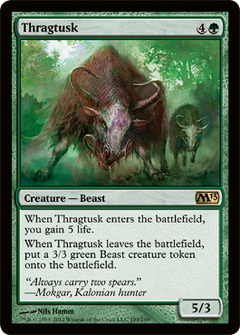 Price in a year: $3
Price in a year: $3
Thragtusk: The value you get from this one card is still quite impressive. It’s in Cubes and EDH decks and not Modern at all, so when he rotates, get these cheap.
Price at Rotation: $3
Price in a year: $6
Reliquary Tower: One of the lands that every EDH deck should consider playing. I like to have these in my binder for when someone tells me they are building a new casual deck. Foils especially, but regular ones will be a good pickup too.
Price at Rotation: 25 cents
Price in a year: $1
Innistrad
Mikaeus, the Lunarch: Yes, he was in FTV:Legends. His effect is very good for one big creature or powering up a casual token army. He’s not used in Standard anymore though, so his price might not change at all.
Price at Rotation: $2
Price in a year: $3
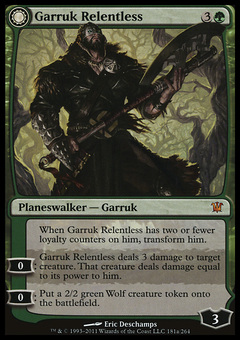 Garruk Relentless: If he drops to $5 or lower, I’ll get all I can. He’s too good for that price. Other such examples: Nissa Revane and Sarkhan Vol. Planeswalkers will always have a certain appeal.
Garruk Relentless: If he drops to $5 or lower, I’ll get all I can. He’s too good for that price. Other such examples: Nissa Revane and Sarkhan Vol. Planeswalkers will always have a certain appeal.
Price at Rotation: $5
Price in a year: $10
Enemy checklands (Sulfur Falls and the like): Just like their M10 counterparts, these are great and easy mana fixing for casual decks. The bonus here is that these are rarer than the ally-colored ones that have been printed four times, so grab all you can when they bottom out. It’ll be easy money before long.
Price at Rotation: $3 each
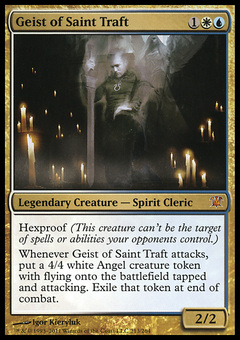 Price in a year: $8 each
Price in a year: $8 each
Geist of St. Traft: I doubt he will go much below $15, because he is used often in Modern and in Legacy. That said, once he rotates, his price will creep upwards. Get in if you can, but I can see people taking their Standard Hexproof deck and turning it into one for Modern.
Price at Rotation: $15
Price in a year: $25
Kessig Wolf Run, Gavony Township: These are the two best utility lands for their colors. They are powerful in different ways but they are easy to add in, because most decks will be able to use such an effect.
Price at Rotation: $1 or less
Price in a year: $2
Dark Ascension
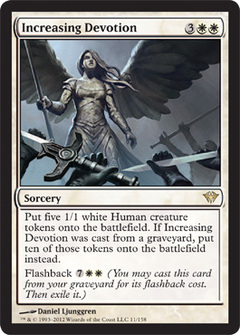 Increasing Devotion: Token decks are always going to be a popular way to play. This is one of the best cards for such decks, and let’s not overlook that they make Human tokens, one of the few cards that makes this relevant creature type. Pick this up cheap and sock it away for a year.
Increasing Devotion: Token decks are always going to be a popular way to play. This is one of the best cards for such decks, and let’s not overlook that they make Human tokens, one of the few cards that makes this relevant creature type. Pick this up cheap and sock it away for a year.
Price at Rotation: 25 cents or less
Price in a year: $2
Thalia, Guardian of Thraben: This little lady does it all. She slows spells, she attacks and blocks well, and has a low mana cost. She’s also popular in certain Legacy and Modern decks, so her price might not fall very far.
Price at Rotation: $3
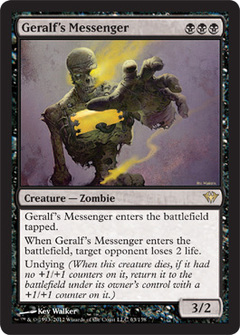 Price in a year: $8
Price in a year: $8
Geralf’s Messenger: A restrictive mana cost and being terrible at blocking mean he won’t see Modern or Legacy play. It’ll be casual or bust for this.
Price at Rotation: $2
Price in a year: $5
Gravecrawler: Zombies are a great tribe and this is a flavor winner. Gravecrawler enables all sorts of combos in all sorts of formats. Keep in mind he’s a buy-a-box foil.
Price at Rotation: $3
Price in a year: $6
Mikaeus, the Unhallowed: Another Zombie whose price is all due to his casual appeal. I’m hoping his price drops to $3 or less, but I wouldn’t be surprised if he stays where he is.
Price at Rotation: $4
Price in a year: $7
Drogskol Reaver: Here’s a card that will be close to bulk at rotation. It’s too good in assorted EDH decks to stay that low.
Price at Rotation: 25 cents or less
Price in a year: $1.50
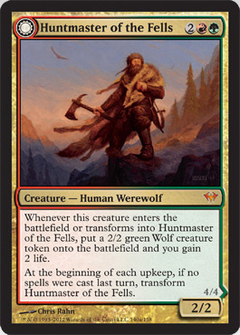 Huntmaster of the Fells: Much is going to depend on price memory for this card. When people think about how much they spent on it in its heyday, they will be reluctant to let it go at the new low price it will get to. It’s a fringe player in Modern currently, but if it dips very low, I’ll pick them up.
Huntmaster of the Fells: Much is going to depend on price memory for this card. When people think about how much they spent on it in its heyday, they will be reluctant to let it go at the new low price it will get to. It’s a fringe player in Modern currently, but if it dips very low, I’ll pick them up.
Price at Rotation: $5
Price in a year: $10
Vault of the Archangel: An outstanding effect on a land, and very popular with the casual crowd Grab them and put them away for a while.
Price at Rotation: $1
 Price in a year: $4
Price in a year: $4
Sorin, Lord of Innistrad: Again, cheap planeswalkers are something to speculate on. It takes one being truly bad to stay at a low price forever. Even Chandra Ablaze is up to $8, and Sorin is much, much better. Remember that he has a Duel Deck foil nudging his price downwards.
Price at Rotation: $8
Price in a year: $20
Avacyn Restored
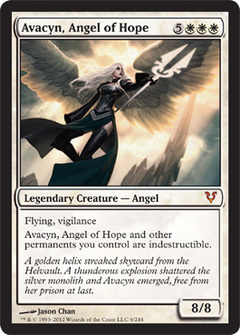 Avacyn, Angel of Hope: Look at this price. Nearly $20 right now, and that is ONLY due to casual appeal. She’s never been played in Standard or Modern or any Constructed format, but this speaks to the power of the casual crowd. Not just EDH, but every deck wants an effect like this. I do not expect her price to go down at all.
Avacyn, Angel of Hope: Look at this price. Nearly $20 right now, and that is ONLY due to casual appeal. She’s never been played in Standard or Modern or any Constructed format, but this speaks to the power of the casual crowd. Not just EDH, but every deck wants an effect like this. I do not expect her price to go down at all.
Price at Rotation: $20
Price in a year: $25-$30
Cathar’s Crusade: Parallel Lives never had a chance to be cheap, the ship has sailed on making good money off of that. This card offers a different kind of power, and will be available at bulk rates. Get a stack of these, they will be buylisted for $1 within a year.
Price at Rotation: 50 cents
Price in a year: $2
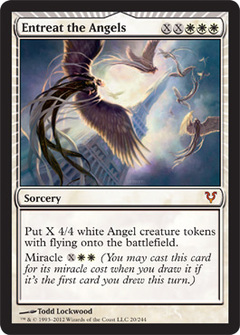 Entreat the Angels: This is a great effect, and when it gets cheap, you should trade for these. Remember, we love Angels and we love tokens!
Entreat the Angels: This is a great effect, and when it gets cheap, you should trade for these. Remember, we love Angels and we love tokens!
Price at Rotation: $4
Price in a year: $10
Terminus: I cannot overstate how good this card is in EDH. With every set, there’s new, powerful creatures that resist destruction. This is one of the best spells to cast and its price will be at an all-time low.
Price at Rotation: $2
Price in a year: $7
Deadeye Navigator: Nearly bulk now, he’s too good to stay that low forever.
Price at Rotation: 25 cents or less
Price in a year: $1
Tamiyo, the Moon Sage: Planeswalker, cheap, powerful. You know the drill by now. But in case you’re not aware, there’s nothing a blue player loves more than to bring spells back to hand after casting them.
Price at Rotation: $7
 Price in a year: $20
Price in a year: $20
Temporal Mastery: I’m aware that Time Warp is cheaper and more consistent. But it remains a fact that there’s a lot of players who love to take extra turns. Pick these up and help those players realize their dreams.
Price at Rotation: $2
Price in a year: $5
Zealous Conscripts: I still can’t believe this is a card. It’s a combo with Kiki-Jiki, and it will be nearly bulk at rotation. It’ll be good for a long time after that.
Price at Rotation: $1
Price in a year: $3
Craterhoof Behemoth: I sold out on these when they had their spike at the beginning of the year and I’ll be glad to pick them up on the cheap when they bottom out. The effect is too strong and too popular to remain inexpensive.
Price at Rotation: $3
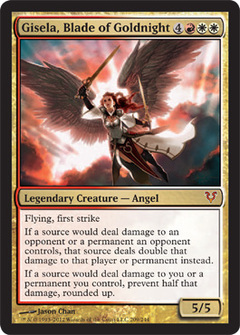 Price in a year: $5
Price in a year: $5
Gisela, Blade of Goldnight: Anything that doubles damage is going to have a high casual appeal. Her ability to halve damage makes things like Pyrohemia amazingly good in EDH. Amusingly, there is exactly one creature that can block her, kill her and live: Withengar Unbound.
Price at Rotation: $3
Price in a year: $10
Sigarda, Host of Herons: A fringe player in Standard for her term, she doesn’t see any play in the Eternal formats. She’s powerful as a Cube or EDH card, especially as a General heading up a Selesnya deck.
Price at Rotation: $2
Price in a year: $6
Bruna, Light of Alabaster: There’s a chance that she gets a lot better with the enchantments coming in Theros block. She is, by far, the best general for an enchantment deck because of her built-in recursion. Others like Uril, the Miststalker or Krond the Dawn-Clad have to work much harder to bring back their Auras.
Price at Rotation: $2
Price in a year: $5
Alchemist’s Refuge: Yes, it requires two colors and three lands, but the effect is undeniably powerful. Something like this is always going to have appeal, no matter the color requirements. Winding Canyons is the nearest example we have.
Price at Rotation: $1
Price in a year: $2
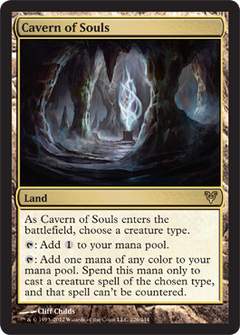 Cavern of Souls: I don’t think this will take much of a hit at rotation. It sees enough Modern/Legacy play to keep its price, and as someone with four tribal EDH decks, I know I’ll be wanting them to get cheap.
Cavern of Souls: I don’t think this will take much of a hit at rotation. It sees enough Modern/Legacy play to keep its price, and as someone with four tribal EDH decks, I know I’ll be wanting them to get cheap.
Price at Rotation: $15
Price in a year: $20
Slayers’ Stronghold: Just like the refuge above, it’s worth stretching your mana a little to get an effect this good. Vigilance, power boost, and most importantly, haste on a land. Hall of the Bandit Lord is our comparison, and some decks will want both of these lands.
Price at Rotation: $1
Price in a year: $3
As always, find me on Twitter @WordOfCommander and tell me why I’m so very right or wrong.
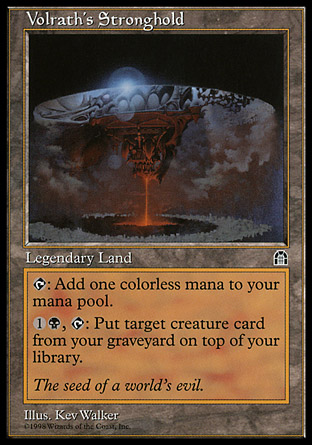



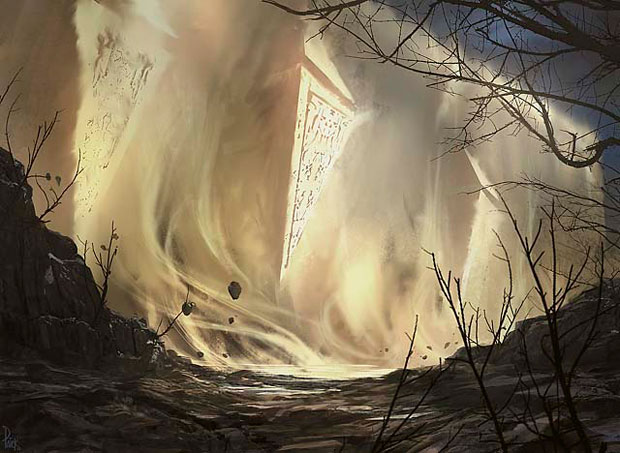
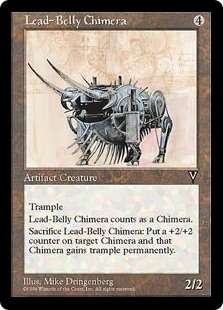


 Price in a year: $3
Price in a year: $3 Price in a year: $20
Price in a year: $20 Price in a year: $3
Price in a year: $3 Garruk Relentless
Garruk Relentless Price in a year:
Price in a year: Increasing Devotion
Increasing Devotion Price in a year: $8
Price in a year: $8 Huntmaster of the Fells
Huntmaster of the Fells Price in a year: $4
Price in a year: $4 Avacyn, Angel of Hope
Avacyn, Angel of Hope Entreat the Angels
Entreat the Angels Price in a year: $20
Price in a year: $20 Price in a year: $5
Price in a year: $5 Cavern of Souls
Cavern of Souls